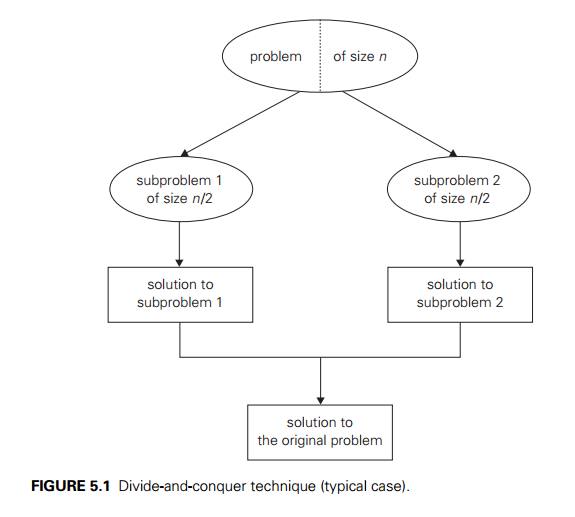Chapter: Introduction to the Design and Analysis of Algorithms : Divide and Conquer
Divide and Conquer
Divide-and-Conquer
Whatever man prays for, he prays for a miracle.
Every prayer reduces itself to thisŌĆöGreat God, grant that twice two be not
four.
ŌĆöIvan
Turgenev (1818ŌĆō1883), Russian novelist and short-story writer
Divide-and-conquer is probably the best-known general algorithm design technique. Though its fame may have something to do with its catchy name, it is well deserved: quite a few very efficient algorithms are specific implementations of this general strategy. Divide-and-conquer algorithms work according to the following general plan:
A problem is divided into several subproblems of
the same type, ideally of about equal size.
The subproblems are solved (typically recursively,
though sometimes a dif-ferent algorithm is employed, especially when
subproblems become small enough).
If necessary, the solutions to the subproblems are
combined to get a solution to the original problem.
The
divide-and-conquer technique is diagrammed in Figure 5.1, which depicts the
case of dividing a problem into two smaller subproblems, by far the most widely
occurring case (at least for divide-and-conquer algorithms designed to be
executed on a single-processor computer).
As an
example, let us consider the problem of computing the sum of n numbers a0, . . . , anŌłÆ1. If n > 1, we can divide the problem into
two instances of the same problem:
to compute the sum of the first n/2 numbers
and to compute the sum of the remaining n/2
numbers. (Of course, if n = 1, we
simply return a0 as the
answer.) Once each of these two sums is computed by applying the same method
recursively, we can add their values to get the sum in question:
a0 + .
. . + anŌłÆ1 = (a0 + .
. . + a n/2 ŌłÆ1) + (a n/2 + . . . + anŌłÆ1).
Is this
an efficient way to compute the sum of n numbers?
A moment of reflection (why could it be more efficient than the brute-force
summation?), a

small
example of summing, say, four numbers by this algorithm, a formal analysis
(which follows), and common sense (we do not normally compute sums this way, do
we?) all lead to a negative answer to this question.1
Thus, not
every divide-and-conquer algorithm is necessarily more efficient than even a
brute-force solution. But often our prayers to the Goddess of AlgorithmicsŌĆösee
the chapterŌĆÖs epigraphŌĆöare answered,
and the time spent on executing the divide-and-conquer plan turns out to be
significantly smaller than solving a problem by a different method. In fact,
the divide-and-conquer approach yields some of the most important and efficient
algorithms in computer science. We discuss a few classic examples of such
algorithms in this chapter. Though we consider only sequential algorithms here,
it is worth keeping in mind that the divide-and-conquer technique is ideally
suited for parallel computations, in which each subproblem can be solved
simultaneously by its own processor.
As
mentioned above, in the most typical case of divide-and-conquer a prob-lemŌĆÖs
instance of size n is
divided into two instances of size n/2. More
generally, an instance of size n can be
divided into b instances of size n/b, with a of them needing to be solved.
(Here, a and b are
constants; a Ōēź 1 and b > 1.) Assuming that size n is a power of b to simplify our analysis, we get
the following recurrence for the running time T
(n):

where f (n) is a function that accounts for
the time spent on dividing an instance of size n into
instances of size n/b and
combining their solutions. (For the sum example above, a = b = 2 and f (n) = 1.) Recurrence (5.1) is called the general
divide-and-conquer
recurrence. Obviously, the order of growth of its solution T (n) depends
on the values of the constants a and b and the order of growth of the
function f (n). The efficiency analysis of many
divide-and-conquer algorithms is greatly simplified by the following theorem
(see Appendix B).

For
example, the recurrence for the number of additions A(n) made by
the divide-and-conquer sum-computation algorithm (see above) on inputs of size n = 2k
is

Note that
we were able to find the solutionŌĆÖs efficiency class without going through the
drudgery of solving the recurrence. But, of course, this approach can only
es-tablish a solutionŌĆÖs order of growth to within an unknown multiplicative
constant, whereas solving a recurrence equation with a specific initial
condition yields an exact answer (at least for nŌĆÖs that
are powers of b).
It is
also worth pointing out that if a = 1,
recurrence (5.1) covers decrease-by-a-constant-factor algorithms discussed in
the previous chapter. In fact, some people consider such algorithms as binary
search degenerate cases of divide-and-conquer, where just one of two
subproblems of half the size needs to be solved. It is better not to do this
and consider decrease-by-a-constant-factor and divide-and-conquer as different
design paradigms.
Related Topics